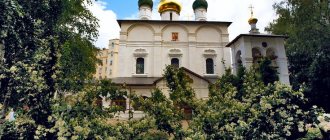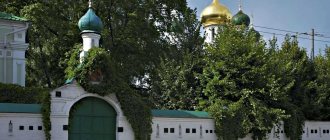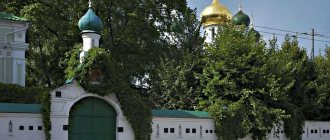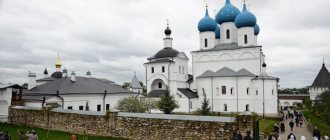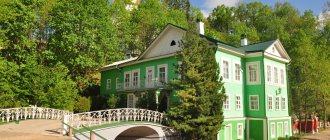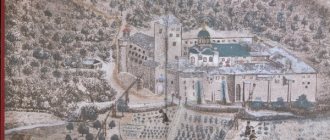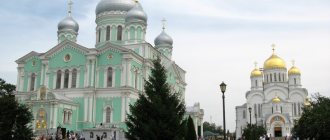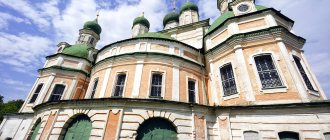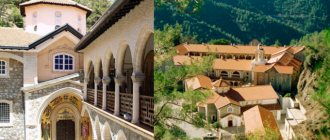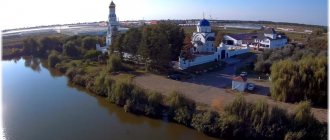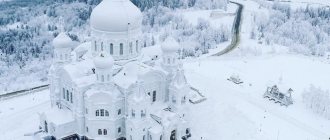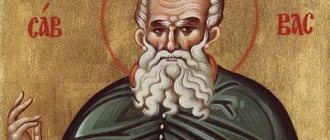| General view of the Moscow Sretensky Monastery along Bolshaya Lubyanka. In the center of the frame is the gate bell tower, to the right is St. Nicholas Church. To the left of the gate you can see the entrance to the Vladimir Chapel. In the background are the chapters of the Sretensky Cathedral. 1881 |
Moscow monastery in honor of the Presentation of the Vladimir Icon of the Mother of God
, stauropegy of the Russian Orthodox Church within the boundaries of the Moscow diocese
- Address: Russia, 103045, Moscow, st. B. Lubyanka, 19, building 1
- Tel.: 628-78-54
- Official site:
- Directions: st. metro stations "Kuznetsky Most", "Lubyanka", "Chistye Prudy", "Turgenevskaya"
- On the map: Yandex.Map, Google map
Founded at the end of the 14th century [1] at the meeting place of the miraculous Vladimir Icon of the Mother of God in memory of the deliverance of Moscow from the invasion of Tamerlane.
According to legend, in the area of st. Dzerzhinsky was the domain of the semi-legendary boyar Kuchka and “Kuchkovo Field”; in the XII-XIV centuries. here was the route from Kyiv and Smolensk to Vladimir on Klyazma, Rostov the Great and other cities. Along this road in 1382, Dmitry Donskoy went to gather troops against Tokhtamysh, and this threat forced the khan, having ravaged the city, to retreat from Moscow. During the invasion of Tamerlane, which in 1395 had already reached the city of Yelets, the Vladimir Icon of the Mother of God was carried along this road from the city of Vladimir to the Kremlin, which Muscovites met on the site of the present Sretensky Gate. A church was erected at the meeting place of the icon, then the Sretensky Monastery. After the monastery, the street was named Sretenki (in the 17th century it was called “Vstretenskaya”).
Sretensky Monastery played an active role in the election of Mikhail Feodorovich, the first king of the Romanov dynasty, to the kingdom. Almost every pilgrimage of kings, patriarchs, metropolitans, princes, and ordinary pilgrims began with prayers at the Sretensky Monastery.
In 1677, the main church of the monastery was built anew and consecrated in honor of the Presentation of the Vladimir Icon of the Mother of God, and the chapel of the Nativity of John the Baptist was added to the southeast.
In the 18th century, significant repairs and reconstruction were carried out at the monastery. The frescoes of 1707 are well preserved - the last masterpiece of ancient Russian art in Moscow.
During the celebration of the Presentation of the Vladimir Icon of the Mother of God, annual religious processions were held from the Assumption Cathedral of the Kremlin to the monastery. In the 19th century, the primate department was temporarily located in the Sretensky Monastery. Until the revolution, there was a cemetery on the territory of the monastery, where participants in the Patriotic War of 1812 were buried. By 1917, the monastery had 3 churches with 6 altars.
After the October Revolution of 1917, Sretensky Monastery became one of the main centers of the struggle against the godless authorities for Orthodoxy. The rector of the monastery in those years was the holy martyr Archbishop Hilarion (Troitsky), an outstanding theologian and preacher. In 1922, the Sretensky Monastery was captured by renovationists, and the renovationist Bishop Antonin (Granovsky) served here on Thursdays and Fridays, albeit “in the old way.” But already in 1923, through the efforts of the Hieromartyr Hilarion, the Sretenskaya monastery became the first to return again under the omophorion of the All-Russian Patriarch St. Tikhon, and its cathedral was reconsecrated with a great rite.
At the end of 1925, the Sretensky Monastery was closed. In 1928-1930, most of the churches and buildings of the monastery were destroyed. Soon a dormitory for NKVD officers was located here. Executions were carried out on the monastery territory adjacent to the buildings of the country's main Cheka. This land was literally soaked with the blood of thousands of new martyrs of the terrible era of persecution of the Church. In memory of all the victims of the atheistic government, a worship cross was installed at the entrance to the monastery in 1995, consecrated by Patriarch Alexy II.
During Soviet times, a secondary school building was built on the site of the cemetery. By 1990, from the former churches of the monastery, one closed church with 2 altars had been preserved.
| View from the southeast of the Vladimir Cathedral of the Sretensky Monastery and part of the new wall with a gate. July 30, 2001. Photo by Komlev A.R. from temples.ru |
In 1991, the preserved Cathedral of the Vladimir Icon of the Mother of God was returned to the Church and opened as a parish church by the Sretensky Orthodox Brotherhood.
In 1993, the courtyard of the Holy Dormition Pskovo-Pechersky Monastery was opened here, in 1995 it was transformed into the Sretensky Stavropegic Monastery.
On May 9-10, 1999, the glorification of Bishop Hilarion of Vereya as a Hieromartyr took place in the monastery.
A bell tower was erected, the ancient monastery premises were restored, two new five-story buildings were built and one four-story building was rebuilt, where the brethren of the monastery and the Sretensky Theological Seminary were located. Nowadays more than forty monks live and work in the Sretensky Monastery. The monastery organizes catechetical courses, which are attended mainly by people who have recently entered church life. Currently, about four hundred people are enrolled in the courses.
Sretensky book publishing house is one of the largest in modern Russia. The publishing house publishes liturgical, theological, historical, fiction, and books on all major areas of religious life.
The Sretensky Monastery also has two monasteries: male and female. The first, in the name of St. Seraphim of Sarov, is located in the Ryazan region. The second monastery, in the name of the prophet of God Elijah, is located in the Moscow region. The brethren of the monastery make regular trips to Chechnya to provide spiritual and material assistance to Russian soldiers and local residents. The Sretensk Higher Orthodox Monastic School, the Russian Center for the Study of the Shroud of Turin, a Sunday school, a publishing house and the online magazine “Pravoslavie.Ru” operate at the monastery. Under the patronage of the Sretensky Monastery, the Resurrection collective farm is being restored. In 2003, the Resurrection cooperative received the state Stolypin Prize as “the most efficient land user in Russia.”
Contact Information
The exact location of the Sretensky Monastery: Moscow, st. Bolshaya Lubyanka, 19, building 1. Exact coordinates: 55°45'56.0″N 37°37'49.0″E.
Contact phone number; 8 (495) 628-78-54
Official website address on the Internet: www.pravoslavie.ru
It is more convenient to get to the monastery by metro, getting off at the Sretenskie Vorota stop. The territory of the Sretenskaya Monastery is a 15-minute walk away.
You should depart from the stations: Turgenevskaya, Sukharevskaya, Kuznetsky Most, Tsvetnoy Boulevard, Chistye Prudy, Lubyanka.
The doors of the monastery are open all days of the week from 6:30 am until the evening.
Inhabitants
In the center of the metropolis
Sretensky Monastery is located in the center of the metropolis. The former abbot of our monastery, now Metropolitan Tikhon (Shevkunov) of Pskov and Porkhov, says on this occasion: “If by the providence of God the monastery is located in the center of a large city and if the Lord brought a monk to it, he should not refuse spiritual and educational service, if the Church calls him to such service.”
Reflecting on the connection between external and spiritual services in the monastery, Bishop Tikhon also says: “The obedience given to the Sretensky Monastery is the education of future shepherds. Is this an external activity of the monastery or an internal one?.. We publish books, this is an external activity - this is how we earn money for the maintenance of the monastery and seminary. But, most importantly, this is spiritual obedience - the internal work commanded to us by Father John (Krestyankin).”
Our ministry
Indeed, more than half of the brothers of the monastery are hieromonks and carry out spiritual obedience, as well as liturgical and spiritual-educational service. Our brethren are educated, almost all of them have graduated from or are studying in seminary, have one or two higher secular educations, and they can provide spiritual guidance to seminary students and parishioners of the monastery.
We carry out many educational projects. Among them: “Common cause. Revival of wooden churches of the North,” the work of the Spiritual and Educational Center named after Hieromartyr Hilarion (Trinity), conversations with parishioners, Sunday school, organization of youth choirs and a youth club, care for a children’s boarding school and the Economic College for the disabled in the city of Mikhailov, Ryazan region, and many others.
Our monastic obediences
Each resident of our monastery also carries out some kind of monastic obedience. Among them are the obediences of the dean and treasurer, housekeeper and cellarer, sacristans, prosphora servers, doctors, and serving clergy. The brethren work in a monastery and a publishing house, in a wholesale warehouse and in church shops, in a pilgrimage service and an online store, in a theological seminary and a boarding school.
Saint Paisius the Svyatogorets: “The monk says a prayer, and with it, in silence, he sends tons of help to his neighbors.”
But we consider prayer to be our main obedience. In the words of Saint Paisius the Holy Mountain: “A worldly man helps the poor with a kilogram of rice and a couple of oranges... But the monk says a prayer, and with it, in silence, he sends whole tons of help to his neighbors.” And the brethren of our monastery follow the covenant of the holy fathers: “The job of a monk is to become a vessel of the Holy Spirit.”
Monastery brethren about obediences
Hieromonk Cleopas (Danelyan) , deputy economist:
Hieromonk Cleopas (Danelyan) – The housekeeper is responsible for the entire economic life of the monastery: construction, the working condition of monastic buildings and monastic equipment, landscaping and cleanliness of the territory. Now, due to the increase in the volume of work, this obedience is distributed among several of our monks, but before, of course, it was more difficult. Work on the monastery, procurement, construction issues - all this went well, but it was especially difficult for me to communicate with the city authorities. Some people know how to build relationships with those in power, but it was very difficult for me.
The peculiarity of economic obedience is that it has neither beginning nor end. Everything related to economics permeates the monastery from all sides. Therefore, there is no end to the work, and it can never end; more and more new cases are constantly opening up.
So now my obedience is constant concern for the earthly needs of monastic life. But this obedience does not interfere with my spiritual life: obedience, in principle, cannot interfere with monastic life. As Saint Ignatius (Brianchaninov) writes: “A useful occupation, especially a service occupation associated with responsibility, does not interfere with maintaining attention to oneself - it guides one to such attention. All the more important are monastic obediences when they are performed properly.”
Obedience does not interfere with monastic life; associated with responsibility, it fosters attention to oneself
What interferes with monastic life—what interferes most of all—is entertainment. Watching a movie, listening to music - this distracts you from monastic life. Murmuring is a distraction, but obedience is not. Sometimes the question is asked: “What can monastic life be like in the center of Moscow, in a metropolis, where there are so many temptations around?” But, to be honest, I don’t notice all these temptations. Vanity does not penetrate into the monastery - unless you add it to yourself.
Hierodeacon Seraphim (Chernyshuk) , sacristan:
“For many years I have been obedient to the sacristan.” A sacristy in monasteries is a room in which all church utensils are stored - vestments (hence the name), vessels, icons, vestments. The person assigned to the sacristy in order to look after all these utensils is called the sacristan. Now the sacristan is engaged not only in this, but in general in all the external arrangement of the temple.
Hierodeacon Seraphim (Chernyshuk) |
The duties of the sacristan in our monastery include cleaning the altar and preparing for the service: bringing prosphora, pouring wine for the Liturgy, preparing vestments. Each holiday requires vestments of a different color - accordingly, on the eve of the holiday, it is necessary to bring from the sacristy vestments of the required color for all priests, deacons and sextons. Of course, the hardest time to work in the sacristy is on the eve of the holidays.
The sacristy was my first obedience in the monastery, although at first, like any worker, I had “hands-on” obediences: sweep the yard, unload books in the book warehouse, help in the garden, etc.
| Brothers of the Sretensky Monastery |
Hegumen Cyprian (Parts) , prosphora book:
Hegumen Cyprian (Parts) – Liturgical life, as we know, cannot exist without prosphoras. And without the Liturgy the Church cannot live. This means that the second place after the temple is the prosphora, where bread is baked especially for the Liturgy. Obedience to the prosphora speaker is of particular importance. Behind the apparent simplicity of this godly activity, there are many subtleties, secrets and hidden activities.
The prosphora of the Sretensky Monastery today is a workshop of an ordinary small bakery production. Nothing special. An oven, a dough mixer, a rolling machine through which the dough is processed (so-called rubbing) so that it acquires a homogeneous, dense structure. Cutting tables, proofing cabinets, where prosphora is suitable before baking.
We don’t have hired people, I bake the service prosphora myself, because the batch is small, I have time, no help is required, the equipment allows it. But the small prosphoras... At our prosphora, seminary students are obedient - they help with cutting, because we need to cut about 3 thousand prosphoras in 2.5 hours.
Baking usually occurs as needed. It depends on the holidays: the more holidays there are, the more often you need to bake. Well, we bake service prosphora three times every two weeks.
Obedience to the prosphora baker is of particular importance, because it is used to bake bread for the Liturgy
How many seminarian assistants have we already had - everyone works hard, tries hard.
I am grateful to the guys for their help and diligence, because they have to carry out this obedience in the evenings, after dinner, when they have free time, that is, this is an additional burden for them. But they hold on to it and work hard. They sometimes carry out this obedience for years until they graduate from seminary. So they want it. You see, baking prosphora... a person should like this business. People have different styles: some paint icons, others do carpentry. Well, he likes the business, he knows it. And we should treat the baking of prosphora the same way. Otherwise it won't work. Because, you see... We still have a problem with living things: living yeast... And a person must like the field in order to successfully complete it.
Mechanically, no, it’s not possible. I didn't realize this before I got into baking. He had a completely different attitude towards prosphora. Firstly, I didn’t know what kind of work it was. Secondly, I didn’t understand the approach at all: just think, what’s wrong with baking prosphora! With this in mind, I came to one wonderful prosphora teacher, Father Adrian at the Novospassky Monastery. “Tell me,” I say, “the recipe.” And he: “Do you know what gluten is? Do you know what IDK is?” These are the characteristics of flour. I thought: “Why is he telling me all this? I just need the recipe!”
And then, when I started baking myself, I realized that I needed to know this, that it was not in vain that he told me these things, because without taking them into account, it is impossible to bake prosphora successfully. Either there must be an enormous amount of experience transferred, or one simply must understand what kind of processes are taking place there.
Brothers of the Sretensky Monastery |
Hieromonk Zosima (Melnik) , obedience in the editorial office of the Internet portal “Pravoslavie.Ru” and the monastery website:
– I am obedient to the editorial office of the Internet portal “Pravoslavie.Ru” and the monastery website: I process and post audio materials on the website – services, sermons delivered in our church.
Our monastery is located not just in the center of Moscow, but in the center of the Moscow traffic jam, which buzzes outside its walls almost 24 hours a day. Of course, the rhythm of city life inevitably affects the monastery itself. We have to focus more on the parish regime: this is how services are structured, and our entire routine and life is connected with the life of the city. Nevertheless, it is also possible to perform night services - more secluded, in a monastic way - and the Midnight Office is served three times a week at 6:45 am - also a purely monastic service, which, even due to the transport conditions of the city, not all lay people can attend.
Hieromonk Zosima (Melnik) |
We also have time for solitude, for performing the monastic cell rule. As they say, those who want look for opportunities, and those who don’t want to look for reasons. Of course, you can always find self-justification for yourself that it is not entirely convenient to be a monk in the city - but anyone who wishes can lead a monastic life even in the center of a metropolis.
Night services are special: there are no lay people at them, we pray alone, like a monk.
Among my obediences was the obligation to answer questions sent to the site.
Sometimes people prefer to go online rather than go to the nearest temple and ask the priest. What is the reason? Some may be lazy, but I think the reason lies in the general barrier of personal communication: now it is much easier for people to communicate on social networks than to go and personally talk to a priest in a temple. Others, perhaps, are embarrassed by their ecclesiastical not only ignorance, but lack of awareness. In church ethics, in traditions, in how one should behave in church. We have to explain the most basic things: how, for example, you should dress when you go to church, or how to fill out a health note correctly. Hieromonk Luke (Aule), radio technician obedience:
“When I came to the monastery, I wanted to bury my talent in the ground. I thought that electronics was a bad, unclean thing. And the Lord humbled me and gave me this obedience so that I would no longer say or think stupid things. If radio electronics are used for good, if it serves people who, thanks to good sound, edify their souls with the word of God, there is nothing seditious in such a skill.
| Hieromonk Luke (Aule) |
I have carried out my obedience for more than ten years.
It started with the need to broadcast from the bell tower for the glorification of the Holy Martyr Hilarion. Where the clock was located, it was necessary to put a speaker so that the divine service could be heard. And my father, the economist, spoke about me for the first time, saying that it was in vain for us to hire any specialists, because we have a person who worked on computer systems in the world. Well, they gave me my first obedience: to do a “voice-over” on the bell tower. Then this matter slowly began to develop. Then the monk Vladimir, who handled telephone communications in the monastery, fell ill. And I was instructed to urgently resolve the issue with the telephone exchange. We bought a new system and redid everything. Now in our monastery we have a very powerful telephone exchange, it has great potential... In general, this is how I began to participate in all projects related to electronics. God directed my skills to serve the Church. Thank God for everything.
These are stories about only a few obediences of the brethren of the Sretensky Monastery, but from them the reader can imagine how diverse the works of the inhabitants of the monastery are.
| Icon “Cathedral of Patron Saints of the Sretensky Monastery” |
History of the founding of the stauropegic monastery
The Sretensky Monastery has been mentioned in chronicles since 1397. Its construction marks the victory of Vasily I over Tamerlane’s army. An Orthodox wooden complex was erected near Kitay-Gorod.
The location for the church was not chosen by chance. Back in 1395, here the highest bishop Cyprian met the Vladimir Icon of the Mother of God, taken from Vladimir on the Klyazma River. A solemn prayer service was held on the occasion of the discovery of the icon.
Since the opening of the church, it has been assigned a vital role in the capital's spiritual life.
In the 17th century, the monastery was moved due to the construction of stone walls of Kitay-Gorod.
The first building was a stone chapel. Thanks to abundant contributions from the treasury, the monastery grew and acquired churches and fraternal buildings.
The year 1737 was significant when fire partially destroyed the monastery buildings. And since 1764, the monastery began to decline, declared unemployed and no longer financed from the royal treasury.
In the 19th century, the revival of the monastery began. During the war with Napoleon, daily services were held in the temple. The monks nursed the wounded soldiers, and buried the dead in the monastery cemetery.
The bells of the Sretensky Monastery were heard over long distances, and numerous pilgrims found shelter on the territory.
The children of Orthodox believers were educated in the parish school.
After the revolution of 1917, stagnation again sets in in the history of the monastery. The rector, Bishop Hilarion, is exiled to Solovki, and the monastery is liquidated. The premises begin to be used for economic needs, which leads to neglect and partial destruction.
Restoration of the Sretensky Church began in 1958, and in the 90s the cathedral was returned to believers. The summer of 1996 was the time of restoration of the monastery.
In the last year of the 20th century, a school was opened, which later turned into a theological seminary.
Choir and chants
All monastery churches have excellent acoustics. This effect was achieved using highly professional equipment. Every word of the clergyman is heard here very clearly.
The monastery choir is known not only in the homeland, but also outside the state. And not only thanks to divine chants. The group's repertoire includes works of Russian folklore, as well as songs from the front-line years. Choir director Nikon Zhila explains:
“For us, these songs contain the idea of preaching not only within the Church for a believer, but simply for a person. These songs can be called the prayer of a secular person, because they are about the most important things: about friendship, about faith, about honor, about love - about what our society cannot and should not live without.”
The seminar choir, according to experts, sounds no worse than the professional choir of the monastery. Students also give concerts and participate in religious services. Hieromonk Afanasy (Deryugin), dean of the monastery, explains:
“All festive services are sung by two choirs: our famous monastery choir and the choir of the Sretensky Seminary.”
Selected chants of the Sretensky Monastery choir
We invite you to watch the video and listen to: Rachmaninov. “All-Night Vigil” performed by the choir of the Moscow Sretensky Monastery.
Educational courses
The courses opened at the monastery in 2014. They are conducted in the conference hall and other classrooms of Sretensky Seminary with simultaneous video recording, which is then broadcast on the Internet portal. Each such post is watched by an average of 30,000 people.
The lectures discuss many Orthodox issues: features of the interpretation of the Bible, the subtleties of Russian dogma, the history of the formation of the Church. Classes are taught by seminary teachers, clergy and laity.
Children's courses are held at the Educational Center. The head of the center, novice Mark Sikoev, explains:
“We hold completely different events. Here children can play games and meet with teachers. There are six studios in the center and all of them are themed to make it very pleasant to be there. Great importance is paid to creative disciplines, where children open up and do something with their own hands.”
Tatyana Rasnovskaya
Educational courses of the Sretensky Monastery
Nowadays, educational courses are held for Orthodox laity in the Moscow Sretensky Monastery. In 2022, meetings are dedicated to family.
Speeches are given by clergy, psychologists and teachers of the Orthodox faith. The gathering place is the lower church of the new cathedral. The event starts at noon. To register for courses, you must fill out an online form.
Monks
Those who decide to connect their lives with the monastery pray here not only for the salvation of their own soul, but also for every Orthodox Christian. Since many pilgrims visit this place every day, obediences are very clearly distributed among the inhabitants. Viceroy Hieromonk John (Ludishchev) explains:
“First of all, these are liturgical obediences. These are the obediences of the sacristan, who makes sure that the vestments are worn and the temple is clean and in proper condition. Then the obedience of the dean, who monitors compliance with the Charter of the monastery.
Economic service in charge of routine repairs and housekeeping work. Prosphora, which Father Cyprian handles for us. The brethren also have the opportunity to serve night liturgies at their own discretion, notifying the dean.”
The monastery has developed a tradition of “fraternal services”, at which all the monks are present. Thursday was chosen for such services, the day on which the Lord established the Eucharist.
Service Schedule
General brief schedule of services:
On weekdays, the midnight office takes place at 06:30, the liturgy is celebrated at 08:00, and the evening services begin at 6 pm.
On Friday evening hours, the akathist to the Mother of God is read.
On Sundays and holidays, liturgies are held at 07:00 and 10:00.
The monastery today
Today, about 40 inhabitants permanently live in the active monastery. The largest Orthodox publishing house in Russia is located here, and the monastery choir performs at holiday concerts in different parts of the country and abroad.
Church services at the monastery are held daily at 6.30 and 18.30.
The monastery has two monasteries, an agricultural cooperative and is in charge of the orphanage in the city of Mikhailov. Gradually, a school building, a hotel and several premises located along Rozhdestvensky Boulevard came into his possession.
Quite recently, a new church dedicated to the New Martyrs of Russia was consecrated at the monastery. It is often called the “Church on the Blood” or the “Temple of Reconciliation” and is considered a tribute to the memory of all those who were repressed and died during the years of active church persecution. Unfortunately, in order for the large-scale construction to take its place, several historical buildings of the monastery had to be demolished.
Bell tower of the Cathedral of the Vladimir Icon of the Mother of God of the Presentation
Shrines
The Cathedral of the Presentation of the Vladimir Icon is still active today; its construction was completed in 1677.
In the Sretensky complex there are two inactive churches: St. Nicholas and Mary of Egypt, rebuilt in 1835.
The following are considered miraculous icons:
- image of the Vladimir Mother of God;
- the face of the hermit monk Seraphim of Sarov and his relics.
Within the walls of the Orthodox monastery are the remains of St. Hilarion (of the Trinity), an x-ray of the famous Turin veil depicting the body of Christ, a small part of the relics of St. Mary of Egypt and particles of the relics of Basil the Great, John Chrysostom and other Orthodox saints.
Sretensky Church
A beautiful old church stands in the center of the monastery courtyard. It appeared in 1679 by decree of the Russian Tsar Fyodor Alekseevich and was built on the site of an older temple that had existed since the end of the 14th century. After the consecration, it was decided to expand the church, and arched porches were added to it on three sides. At the beginning of the 18th century, the western porch was converted into a porch, and a chapel dedicated to the Nativity of John the Baptist appeared near the southern facade.
Despite repairs and reconstruction, the appearance of the ancient building has changed slightly. Sretensky Cathedral represents one of the best examples of Moscow-Yaroslavl temple architecture. It consists of a two-height quadrangle divided into three naves and three apses. Several years ago, a gallery with a small elegant belfry was added to the temple.
The outer walls of the cathedral are decorated with three arches, and large icons can be seen in the gaps between them. The quadrangle is topped with five onion domes. The massive drum supporting the central chapter is illuminated, and the rest are decorated with decorative windows.
View of the Cathedral of the Vladimir Icon of the Mother of God of the Presentation from the rear
Inside there is a five-tiered tyablo iconostasis, made in 1995. The lower part or crypt is decorated with white marble and mosaics. It contains an exact copy of the famous Shroud of Turin, made in life size. Believers come here to pray in front of ancient icons and pieces of relics of Christian saints.
The unique frescoes of the Sretensky Church were completed in 1707, during the transition to the Baroque. The customer for the wall paintings was the steward Semyon Fedorovich Griboedov, and the temple was painted by talented isographers invited from Kostroma and Yaroslavl.
Requirement cost
Religious rites performed according to the demands and requests of believers are called requirements performed in various faiths. Requirements are not included in the mandatory daily schedule of services.
It is better to find out the amount of fees for services according to requirements or notes directly in the temple.
Approximate amounts of donations for services performed for health or repose:
- mass, including 10 names in 1 note - about 20 rubles;
- Magpies for 1 name about 150 rubles;
- prayer service and service for the deceased, containing 10 names in 1 note - 30 rubles;
- psalter of prayer chants 1 name from 200 to 2000 rubles, depending on the number of days for which it is ordered.
War of 1812 and its aftermath
On August 26 (September 8), during the Battle of Borodino, a religious procession with miraculous icons moved from the monastery, which walked in the middle of convoys with wounded Russian soldiers. The people prayed to the Most Holy Theotokos to save Moscow and Russia from the Napoleonic horde. Moscow was surrendered, but Russia and the Orthodox faith remained unharmed.
At the Sretensky Monastery, the French were met by several monks; church valuables and the treasury were taken to Kazan. The soldiers lived in the looted churches, and a hospital was set up here. Every day, at the risk of their lives, the monastic brethren prayed in the surviving church of St. Nicholas the Pleasant for Emperor Alexander I and the victory of Russian weapons.
After Napoleon left, the monks treated Russian soldiers in the monastery infirmary, and the dead were buried here in the monastery. a cemetery for participants in the Patriotic War of 1812 appeared in the Sretensky Monastery
On December 12, 1812, a procession of the cross took place from the Sretensky Monastery in Moscow with the icon of the Vladimir Mother of God: this is how the capital was consecrated after the presence of enemies in it. The Commander-in-Chief of Moscow, Count Rastopchin, read reports about new victories of the Russian army. Fireworks rang out from captured French guns mounted near the walls of the monastery.
Relics of Hilarion
Particularly revered in the Sretensky Monastery are the relics of the Hieromartyr Hilarion.
Hilarion was born in 1886 into the family of a clergyman in a village located in the Tula province. All his life he studied diligently, was engaged in scientific works, and became a monk in 1913.
After the revolution, Hilarion did not reject his faith and continued to conduct services and work on historical works. In 1921, he was arrested, the reason for which was the organization of a crowded prayer service within the walls of the Sretensky monastery.
After spending a short time in prison, the archbishop was released and again taken into custody two years later. After several years on Solovki, Illarion was sent to Kazakhstan. On the way, he was robbed, and he, suffering from typhus, ended up in Leningrad.
In December 1929, the 43-year-old archbishop died in delirium. Dying, he insisted that he had found the long-awaited freedom. During the funeral service, it was impossible to recognize the former Hilarion in the exhausted old man.
A year before the beginning of the 21st century, the archbishop was canonized and his holy remains were transferred to the Sretenskaya monastery. Memorial Day – December 15th.
What can a worker in a monastery count on?
In addition to the most important thing - closeness to God, the worker receives bread and shelter in the monastery. In this case, the word work has a slightly different meaning. For an ordinary person, bread and shelter are obtained by labor; for a worker, this is a way to maintain life. After all, he came to work not for food, but to serve the Lord with his labor.
The basis of labor is physical labor, as the most effective means for cleansing the body and mind. Therefore, in the monastery there are no accountants, secretaries, and so on. Simple food, physical work most of the time, and the rest of the time talking with the Lord through prayer - this is what awaits those who want to work for the glory of God.
Most often, the employee is not assigned any specific position or responsibility. Today it could be laying bricks, tomorrow caring for a garden or vegetable garden, and a few days later working in the kitchen or inside the monastery itself. It all depends on the needs of the monastery. When selecting a job, the physical condition and gender of the person are taken into account.
